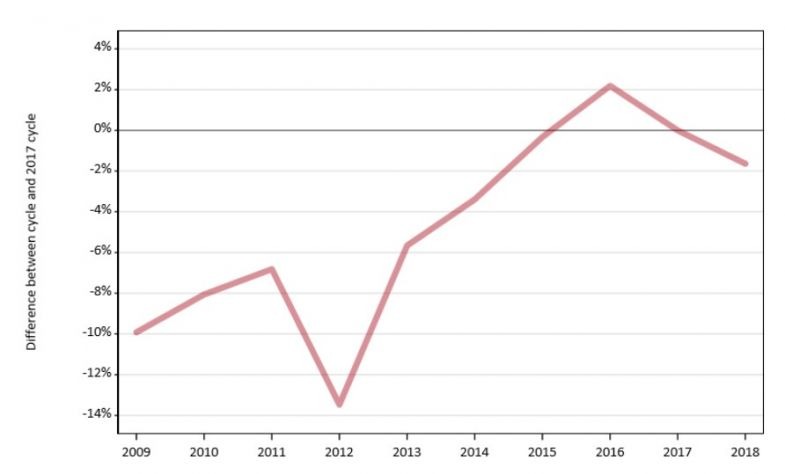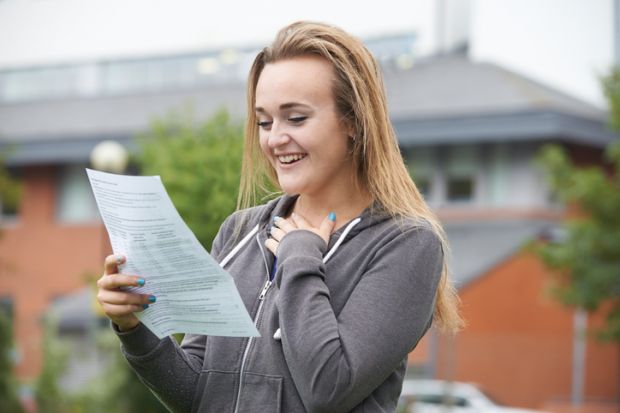Lower-tariff universities are bearing the brunt of a fall in acceptances to UK universities in 2018 stemming from a decline in the number of 18-year-olds in the general population, Ucas analysis on A-level results day shows.
Ucas released figures showing that across UK institutions 411,860 students had been placed on an undergraduate course, a 1 per cent decrease on results day last year.
But for UK-domiciled students there was a 2 per cent decrease compared to A level results day 2017.
This is largely because of a 2.5 per cent drop in the number of 18-year-olds in the UK population, according to Ucas.
All placed applicants from the UK:

In England, a record 27.9 per cent of the 18 year old population received acceptances through Ucas. The rate was 26.3 per cent in Wales, 28.1 per cent in Northern Ireland and 25.9 per cent in Scotland (where students received their exam results last week).
The data show that higher-tariff institutions – those with the top entry requirements – managed to boost their overall number of placed applicants this year by 1 per cent, to 133,860, whereas lower-tariff institutions saw a decline of 3 per cent – 4,070 students – this year. But that was an improvement on the 6 per cent decline the previous year. Middle-tariff institutions also lost out, by 1 per cent.
The figures show a continuation of the trend started in 2016, after the removal of student number controls, for lower-tariff universities to lose out to higher-tariff institutions in the competition to increase their undergraduate population.
Despite the fall in 18-year-old population, the number UK-domiciled students placed at higher-tariff institutions declined only slightly by 190 students - less than 1 per cent - but the lower- and middle-tariff figures reflected the overall picture, dropping 3 per cent and 1 per cent respectively. Higher-tariff institutions saw their number of non-EU international students placed this year increase by 1,200, to 6 per cent, whereas the number placed at lower-tariff institutions dropped 2 per cent and middle-tariff institutions stayed the same.
Placed applicants from the UK by tariff group

The number of placed applicants to nursing was also down this year, continuing the drop that started in 2017 after nursing bursaries were replaced with loans. The number of students placed on nursing courses this year was 21,030, a 2 per cent decrease from last year.
The data also show a small rise in the percentage of students from the most disadvantaged groups accepted to universities, by 0.4 percentage points to a record high of 16.1 per cent. However, the gap between the most and least advantaged groups remains the same as last year, Ucas said
Clare Marchant, Ucas chief executive, said that the increase was “excellent news” but added that the continuing gap was “frustrating”. “We’ll keep on working with universities to help them evaluate their outreach activities to impact the most disadvantaged students,” she said.
This year also saw an increase in the number of overall acceptances for students from the EU by 1 per cent, alongside a record 31,510 students from outside the EU, an increase of 4 per cent.
The Council for the Defence of British Universities said that “the fall in applications has led to fierce competition between universities, a drop in income and an uncertain future for both students and staff.
“With 26,000 places still unfilled on results day, the providers of places are struggling to survive in the present funding system. The now almost complete replacement of the block grant for teaching with income from tuition fees means they have to bring in enough students or ultimately go under.”
Register to continue
Why register?
- Registration is free and only takes a moment
- Once registered, you can read 3 articles a month
- Sign up for our newsletter
Subscribe
Or subscribe for unlimited access to:
- Unlimited access to news, views, insights & reviews
- Digital editions
- Digital access to THE’s university and college rankings analysis
Already registered or a current subscriber? Login







